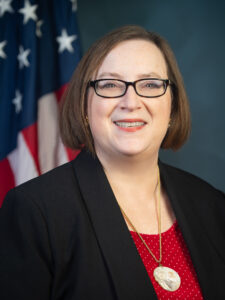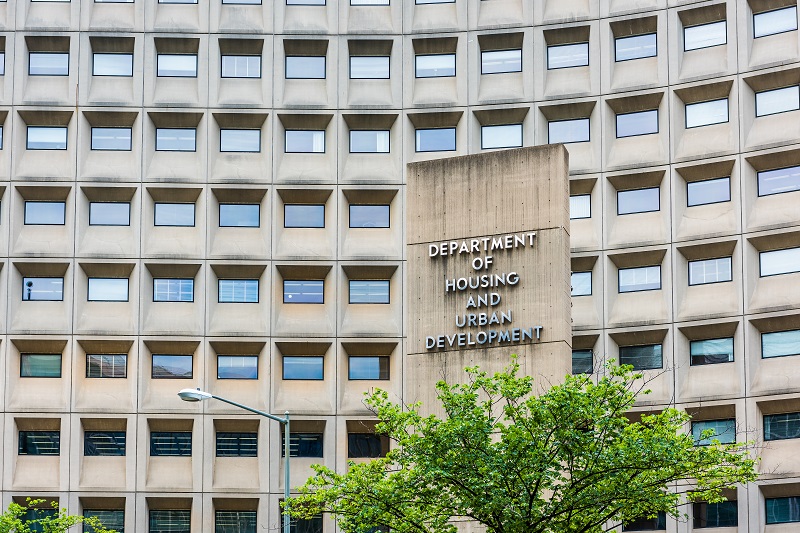This piece originally appeared in the April 2023 edition of MortgagePoint magazine, online now.

Julia R. Gordon has served as the Assistant Secretary for Housing and Federal Housing Commissioner at the U.S. Department of Housing and Urban Development (HUD) since being confirmed by the U.S. Senate in May 2022. She came into the role at a time when the housing market and larger economy were still navigating aftershocks from a global health crisis, while at the same time, low interest rates were fueling the market. For a long-time industry professional whose official bio describes her as “a strong advocate for and hands-on practitioner working to achieve equal justice, fairness and equity in housing, and consumer protections,” there were challenges to face, certainly, but also opportunities for her to lean into the kind of meaningful work that has defined the arc of her career thus far.
In her role at HUD and the Federal Housing Administration (FHA), Gordon helps oversee HUD’s operations supporting homebuyers, homeowners, renters, and communities alike. She is responsible for FHA’s Single-Family, Multifamily, and Healthcare mortgage insurance programs, which together encompass more than 7.5 million homeowners, some 1.4 million rental households, and thousands of hospitals and residential care facilities. She also oversees HUD’s Multifamily assisted housing portfolio, which serves more than 1.2 million low-income households.
Having begun her career as an attorney, Gordon’s path to her current role took her through work with organizations such as the National Community Stabilization Trust (NCST), the Center for American Progress, the Center for Responsible Lending, and the Federal Housing Finance Agency (FHFA). Across these roles, she has been closely involved in grassroots efforts to shape mortgage and housing finance laws, regulations, and programs to protect homeownership and family wealth, including the Dodd-Frank Wall Street Reform Act and the Making Home Affordable program.
For our debut issue of MortgagePoint, we got the chance to speak with Commissioner Gordon about how she arrived in her current role, what she hopes to accomplish there, and where her focus and priorities are being directed.
(Editor’s note: Commissioner Gordon will also be delivering a keynote speech at Five Star’s Government Forum event on April 11 at the National Press Club in Washington, D.C. For more information, please visit fivestargovernmentforum.com.)
Q: HUD recently marked a milestone of helping approximately two million homeowners with FHA mortgages stay in their homes via forbearances and loan modifications, as well as confirming that these options would be available for at least another 18 months from when that announcement was put out. Could you talk about some of the biggest lessons you’ve taken away from these programs and how they’re helping people navigate the continuing economic challenges we’re seeing?
We have learned a variety of lessons, some of which were mainly confirming information that we had learned during the financial crisis. Here are a few things that I think are core lessons. First, alignment across channels and collaboration among those channels in responding to a crisis is absolutely critical. FHA was very fast off the blocks when the pandemic hit, and then there was a lot of coordination among FHA, VA, and USDA, as well as Fannie Mae and Freddie Mac. That coordination sent a clear signal to the public. The CARES Act forbearance option was understandable. For the most part, it didn’t depend on who owned your mortgage.
Another thing that this experience demonstrated was that getting assistance to borrowers quickly and without a lot of paperwork and back and forth is critically important. There has always been an overly heavy focus on the moral hazard of assisting a borrower who hasn’t jumped through multiple hoops to explain how deserving they are of this assistance. But the fact is, if you look at crisis after crisis, there is no history of the typical troubled borrower gaming the system. We saw that at work with the forbearances, and then we saw that at work with the COVID-19 waterfall of loss mitigation solutions. When you take out the extensive and onerous paperwork, you can get assistance to people quickly, and it is as effective as doing it the other way.
We also confirmed what research had shown after the financial crisis: the factor that is most important for borrower success—meaning a borrower who goes delinquent, comes back to re-performing status, and stays there—is the level of monthly payment reduction that we’re able to provide. Now, the pandemic was different from 2008 because of the very quick and severe dislocation we experienced economically and socially. We had households take advantage of the forbearance opportunity even when they didn’t necessarily know if they would need it, but they were taking it to take one form of anxiety off their plate while they dealt with all the other forms of anxiety. So, there were borrowers who didn’t need that payment reduction when they came back into performance.
When borrowers are ready to restart their mortgages, the servicer first finds out if they can continue to make the monthly payments they were making before. Then we put the arrearages into a second lien and the borrower pays what they were paying before. That works for people who ended up in the same job or at the same income level and just had that moment of uncertainty when the world came to a halt. But for people who did lose their jobs or experienced health effects resulting in disability or even death for somebody in their household or paying for the increased childcare expenses that everybody had to incur, for those folks, we provided additional options for them to get a monthly payment reduction, again in a streamlined way. This is why I think our performance has been so good in helping people bring their mortgage payment current.
Finally, the highly intensive dialogue between FHA, the other channels, and the servicers was extremely useful and marked a significant difference from what happened at the beginning of the financial crisis in 2008. That dialogue included not just the government entities and the servicers but also the consumer advocates. There are strong relationships among all those parties. There are regular channels for communication; there are personal relationships across the different sectors. All of that fed into what was ultimately a great deal of success with the mortgage-related response to the pandemic.
Q: You also recently announced a reduction in mortgage insurance premiums on FHA mortgages, estimated to save people an average of about $800 annually. Could you speak about what led to this decision and why now was the right time for this change?
We were very excited to be able to make this change. As the industry had noticed, our capital reserve ratio, which is required to be over 2%, had crept up over time to more than 11% by the end of fiscal year 2022. What that meant was that FHA was in a very strong financial position, and as the underlying mortgage market changed—in particular, when we saw that very steep rise in interest rates—we started thinking “What can we do to help aspiring homeowners get into the market, even in the face of these higher rates?”
Even though FHA was already quite strong coming into 2020, there was too much uncertainty about the pandemic to make a change in the premium at that time. Today, while we still have a higher number of delinquent borrowers than we would have in a perfect world, we have a good sense of the risks and costs associated with that. So, between our very strong financial position, the fact that we had managed successfully through the pandemic, and that we saw prospective homeowners suffering in this market—both from higher rates and the unprecedented rate of home price appreciation we’d seen during the pandemic—we felt like it was core to our mission to try to reduce the premium that we charge.
We are here to help people when they can’t be served by other means. We have an upfront premium as well as an annual premium, and we focused on the annual premium because most people finance their upfront premium, and that means if we had changed that, the monthly savings would have been quite small amortized over the length of the mortgage. Changing the annual premium was going to give us the greatest monthly payment savings for borrowers, which we felt would put money in their pockets both immediately and going forward.
Q: We spoke with Brian Montgomery a few times in recent years when he was in your role, and he often spoke about the focus on upgrading FHA’s technological infrastructure. Where does that priority stand now, and what remains to be done?
IT modernization is at the heart of moving forward into the future. IT modernization work is hard everywhere in the industry, but it is hardest inside a government agency where you work with, in our case, a CIO who must manage the needs of the entire Department, not just FHA, and where we work through complex government procurement processes. It’s challenging at every moment, but it must be a top priority. You can’t be involved in mortgages and housing without it being a top priority. Technology plays an ever-larger role in everything we do in every sphere of our professional and personal lives, and the mortgage business is no exception. At FHA, we seek to deliver the best and most modern technology we can for lenders, servicers, and other external partners, as well as internal partners.
Some of the work that Brian Montgomery, in particular, had done on IT modernization laid the groundwork for what we are doing now. Having electronic case binder submission technology in place kept our business operational at the height of the pandemic stay-at-home orders. I don’t know what would’ve happened if we were still working off paper files. We also now have the updated claims system and the single-family default monitoring system, and these core building blocks of FHA Catalyst have taken us a long way. But multiple systems still need to be upgraded. We are now working in an agile development environment where systems will continue to improve and change over time. It’s not like, “Okay, we finished project X, now we never have to think about it again.”
All our technology has to be upgraded, enhanced, expanded, and tweaked. The way the government process works, in terms of the budget and getting budgetary authority for technology expenditures, and then having oversight from a variety of different quarters, it often gets in the way of that agility. That said, we are proceeding to improve technology as quickly as we can. We have several things in process right now, both on the single-family and the multifamily side, that we’ll start rolling out in the next few months. It’s important for everybody who cares about FHA to know what a significant priority this is and how this is one issue that the FHA senior leadership team works on and deals with every single day.
Q: What items are on your short list of things you hope to have accomplished by the end of your tenure in this position?
I came in with twin overriding goals. I wanted to make access to credit fairer and more available, particularly to historically underserved communities, and I wanted to prevent unnecessary foreclosures. In both of those areas, I feel fortunate that this team had already been moving well along on those priorities before my arrival, and my interest in those priorities has helped us step up the pace. This has been a period where every team has been working flat-out for a very, very long time, really since the beginning of the pandemic. In our Single-Family program, I am so proud of the work that the team has done. We have rolled out so many new policies, many of which are directly responsive to requests we’ve heard from the industry that were needed to help us achieve these goals that our external partners share.
The people who choose to work in the area of FHA lending care about serving the borrowers who might not be served by the conventional market. Of course, reducing the mortgage insurance premium is a big-ticket item. But some of the things we’ve done on the underwriting side, particularly rightsizing how we look at student loan debt and adding the indicator for positive rental history into our underwriting process are two other important changes that are particularly important for borrowers of color. I’m also proud of the more administrative or technical accomplishments such as keeping the Single-Family Handbook as updated as we possibly can, improving the Frequently Asked Question system, and improving the FHA Resource Center. We’ve been doing quite a lot to not only help qualify more borrowers but also to help the lenders who are doing the work on the ground with borrowers.
On the foreclosure prevention side, during the pandemic, the overriding focus was on rolling out the COVID-19 forbearance and then rolling out the COVID-19 waterfall. This was a tremendous amount of policy change in an extremely short period, which has not always been HUD’s trademark. Even after achieving success in assisting that first tranche of borrowers who came out of forbearance, we are continuing to develop enhanced and new tools to help the borrowers who are now entering into a very different interest rate environment. As I’m sure you know, the traditional loan modification is one where you adjust the rate and term to try to get some monthly payment reduction. With the COVID-19 waterfall, we initiated a 40-year term connected with a partial claim because that was all we had the regulatory authority to do. Just recently, we finalized a regulatory change so that a borrower can get a 40-year modification regardless of whether they have a partial claim.
Now, we are turning our attention to rates. FHA works differently here from the GSEs. The lender must pull the loan out of the MBS pool to modify it, which means that the modified mortgage needs to be adjusted to current rates. Since we had such low rates for so long, many of the borrowers who need our assistance are coming in with rates where a modification increases the rate to the point where it washes out all the benefits of adjusting the term. What we’re looking at now is what we can do to help with the rates.
We’re hoping to propose a new tool that we can use to help reduce borrower payments without having to reset that rate, which we’ll share for comment on our Drafting Table web page soon to get stakeholder feedback.
All these things may sound basic, but they’ve required the work of the entire Single-Family team, not to mention all the attorneys we work with in our Office of General Counsel, and the folks we work with at OMB. It’s a group effort that must go forward to make what I think is the most significant set of changes that HUD has made to its loss mitigation solutions in quite some time.
Q: Earlier in your career, you spent time at both the National Community Stabilization Trust and the Center for American Progress. How did your career bring you to this point, and what did you learn in those roles that you were able to carry over to where you are now?
I am, by training, a lawyer, although I have not practiced law in quite some time. Coming out of law school, my interest was in working with people and communities who were underserved and facing a lot of challenges. That led me to start my career working in the civil legal aid space, providing legal assistance to low-income people and communities. That’s where my heart is; that’s where my mission lies. I came into the federal policy arena just before the financial crisis at the Center for Responsible Lending (CRL). I started as a consumer finance attorney working across a variety of consumer financial products. This was about four months before the first Bear Stearns fund collapsed in 2007. After that happened, I did all mortgage, all the time.
This was a time when I had a young child at home. I did not anticipate that I would find myself working at the center of the most meaningful financial crisis since the Depression, or that my four-day-a-week job would quickly morph into a seven-day-a-week job. Working for the Center for Responsible Lending was an amazing experience. While CRL is a policy institution, they are connected with a CDFI that worked in the mortgage business, which grounded all our policy work in real markets, real transactions, real borrowers, and real situations. That demonstrated to me that the best policymaking comes from people who are connected in some way with what’s happening on the ground.
What shaped the trajectory of my career was chasing unfinished business. I worked at CRL through the passage of Dodd-Frank and worked very hard on Title XIV, the mortgage title. As you know, the one thing Dodd-Frank did not tackle was the status of Fannie Mae and Freddie Mac, so after the legislation passed, I sought work at the Federal Housing Finance Agency, the GSEs’ regulator and conservator. At FHFA, as a mid-level supervisor, I ultimately missed the ability to have a larger platform and to think more broadly. That led me to the Center for American Progress, where I had an amazing platform to engage with policymakers and to understand how “the sausage was made” in both the White House and Congress.
Yet after a few years of work in a think tank, I felt I needed that connection to the local markets again. If you’re not actually working in the business, your big ideas might get a little stale. That’s when I moved over to the National Community Stabilization Trust, which was focused on the issue of vacant homes and all that blight left in disinvested neighborhoods after the crisis. The high-income areas had fully come back, and home price appreciation was happening, but you had so many neighborhoods that were left out of this progress, and one of the reasons for that was all the vacancy and blight. NCST worked to put those homes back to productive use.
At NCST, I launched an effort to work on policy issues, because I knew how much sense it makes to develop policy within the context of an organization that’s also working on the business side. I was at NCST for six years. I learned so much about how mortgage markets were working in disinvested areas—or how they weren’t working. I was one of the early voices to raise an alarm about the role that private investors were playing in terms of buying up vacant homes and turning them into rentals. I gained a lot of experience in understanding how different disposition channels work and how the auction websites were changing the face of disposition.
My position at FHA allows me to draw on all the previous experiences I’ve described and is truly a dream job for me.






